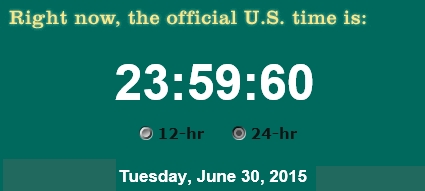Today we get the gift of time. Leap Day, February 29, gives us 24 hours that are usually missing from our calendars.
You probably know we have to insert this day every four years because the earth revolves around the sun in approximately 365.25 days. To make the calendar match the stars and seasons we add an extra day every fourth year with a complicated century exception. The 4-year-old video above explains the details of this astronomical problem and how Julius Caesar and Pope Gregory XIII figure into it.
Last June 30 we received the gift of an extra second. You probably missed it because it happened just before midnight.

Leap Years and Leap Seconds are unrelated but caused by a similar problem. Just as calendars must adjust for Earth’s rotation, so too must atomic clocks. The clocks are extremely accurate but Earth’s rotation is slowing down and not even at a consistent rate. An extra second is added whenever the difference between mean solar time (UT1) and Coordinated Universal Time (UTC) reaches 0.9 seconds. The need for this second is so unpredictable that it’s announced only six months in advance. Computers hate this but there are workarounds.
In the past eight months we’ve gained 24 hours (on February 29, 2016) + 1 second (on June 30, 2015) + 1 hour (changed to Standard Time on November 1, 2015). This nets us 25 hours + 1 second.
Do something fun with the gift of time. Happy Leap Day!
p.s. We’ll lose an hour in two weeks on Sunday March 13 when we switch to Daylight Savings Time. Yikes!
(Leap year video by Epipheo on YouTube. Leap second illustration from Wikimedia Commons; click on the image to see the original)









